
- •Icons in Body Text
- •Introduction to the Dictionary
- •Overview of the functions
- •Data objects in the ABAP Dictionary
- •Data types
- •Exercise 1: Basic Data Types
- •Exercise 2: Simple and Nested Structures
- •Exercise 4: Deep Structures
- •Tables
- •Summary
- •Exercise 5: Tables in the ABAP Dictionary
- •Pooled and cluster tables
- •Performance During Table Access
- •Improved Performance through Access per Index
- •Improving the Performance through Table Buffering
- •Exercise 6: Performance Aspects with Table Access
- •Task 1:
- •Input Checks
- •Input check via the technical domains
- •Object Dependencies
- •Activation and Where-Used List
- •Changes to Tables
- •Database Changes to Transparent Tables
- •Enhancement of SAP Standard Tables
- •Exercise 9: Changes to Database Tables
- •Views and Maintenance Views
- •Restricted or Enhanced Views on Database Tables
- •Exercise 11: Views
- •Creating Maintenance Views
- •Exercise 12: Maintenance Views
- •Search Helps
- •Input helps
- •Exercise 13: Search Helps
- •Table ZEMPLOY##
- •Table ZDEPMENT##
- •Table ZEMPLOY##
- •Table ZEMPLOY##
- •Table ZDEPMENT##
- •Table ZDEPMENT##
- •Check table T000
- •Check table SCARR
- •Check table ZDEPMENT##
- •Check table SCURX
- •Check table STRAVELAG
- •Check table ZDEPMENT##
- •Check table T002

Unit 1
Introduction to the Dictionary
Unit Overview
You can see the chapter overview in the overview of the individual lessons in this chapter.
Unit Objectives
After completing this unit, you will be able to:
•Name the function of the ABAP Dictionary in the R/3 system
•Describe the possible ways of defining data objects and data types
•Describe the services provided by the ABAP Dictionary
•Explain how the ABAP Dictionary is linked to the development and runtime environments
Unit Contents |
|
Lesson: Overview of the Functions of the ABAP Dictionary ................. |
2 |
2006/Q2 |
© 2007 SAP AG. All rights reserved. |
1 |
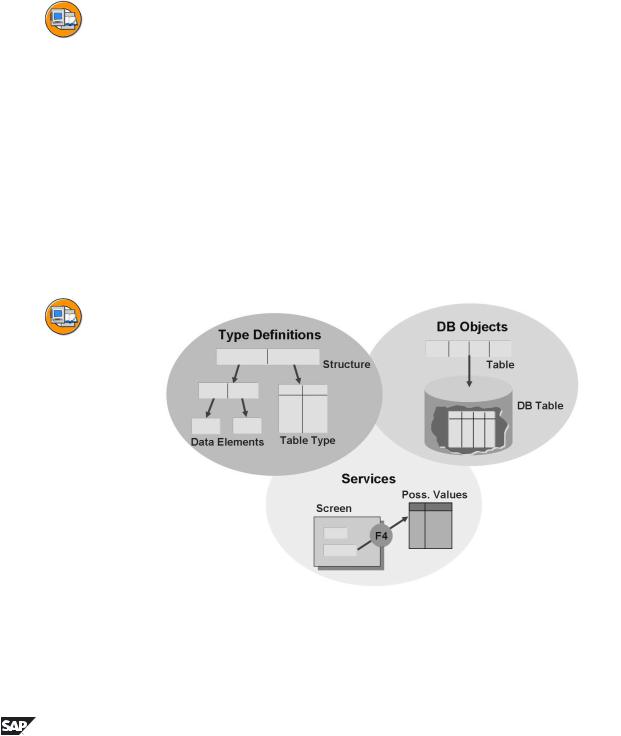
Unit 1: Introduction to the Dictionary |
BC430 |
Lesson: Overview of the Functions of the ABAP
Dictionary
Lesson Overview
In this lesson, you will gain an overview of the funtional scope of the ABAP Dictionary
Lesson Objectives
After completing this lesson, you will be able to:
•Name the function of the ABAP Dictionary in the R/3 system
•Describe the possible ways of defining data objects and data types
•Describe the services provided by the ABAP Dictionary
•Explain how the ABAP Dictionary is linked to the development and runtime environments
Business Example
You should explain the main possibilities offered by the ABAP Dictionary to a colleague
Overview of the functions
Figure 1: Function of the ABAP Dictionary
2 |
© 2007 SAP AG. All rights reserved. |
2006/Q2 |
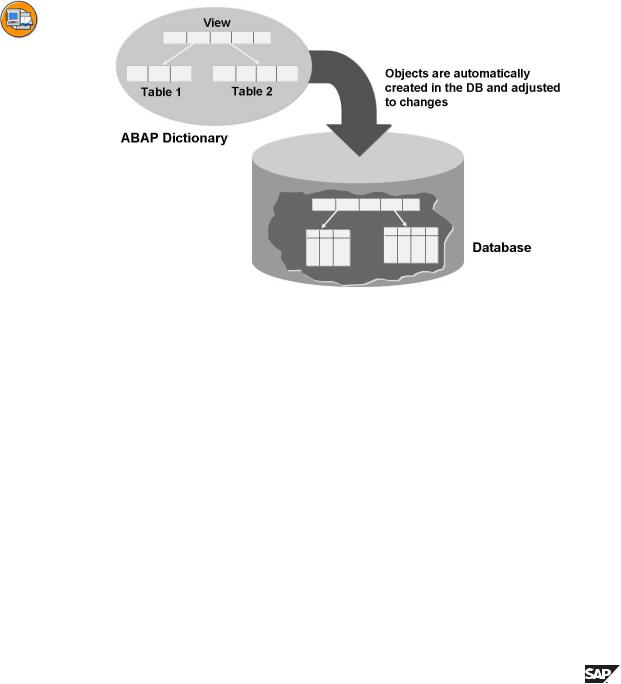
BC430 |
Lesson: Overview of the Functions of the ABAP Dictionary |
The ABAP Dictionary permits central management of all the type definitions used in the R/3 System.
In the ABAP Dictionary, you can create user-defined types (data elements, structures, and table types) for use in ABAP programs or in interfaces of function modules, object methods, etc. Database objects such as tables, indexes and views can also be defined in the ABAP Dictionary and created with this definition in the database.
The ABAP Dictionary also provides a number of services that support program development. For example, setting and releasing locks, defining an input help (F4 help), and attaching a field help (F1 help) to a screen field are supported.
Figure 2: Database objects in the ABAP Dictionary
Tables and database views can be defined in the ABAP Dictionary.
These objects are created in the underlying database with this definition. Changes in the definition of a table or database view are also automatically made in the database.
Indexes can be defined in the ABAP Dictionary to speed up access to data in a table. These indexes are also created in the database.
2006/Q2 |
© 2007 SAP AG. All rights reserved. |
3 |
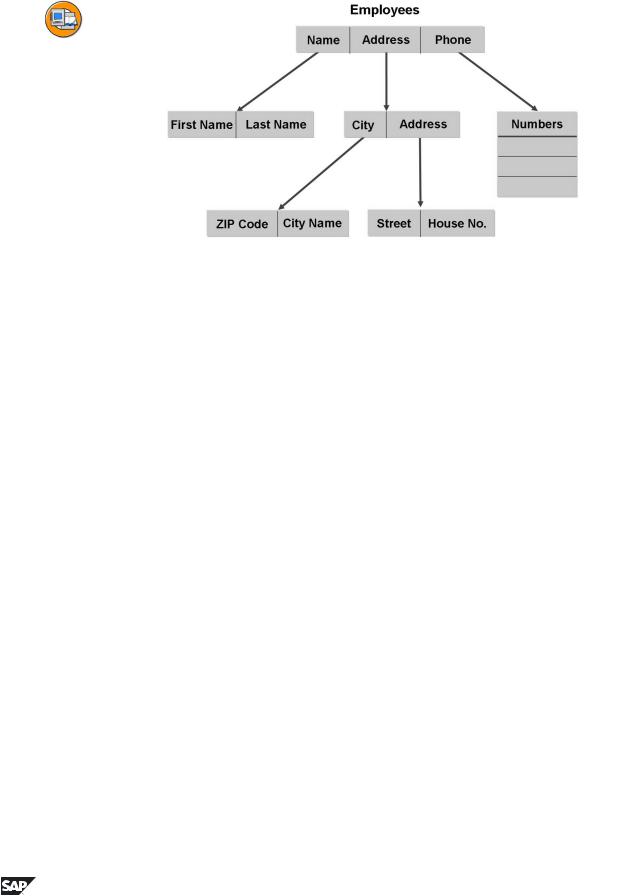
Unit 1: Introduction to the Dictionary |
BC430 |
Figure 3: Type Definitions in the ABAP Dictionary
Three different type categories exist in the ABAP Dictionary:
•Data elements:Describe an elementary type by defining the data type, length, and possibly decimal places.
•Structures: Consist of components that can have any type.
•Table types: Describe the structure of an internal table.
Any complex user-defined type can be built from these basic types.
Example: The data of an employee is stored in a structure EMPLOYEE with the component’s NAME, ADDRESS and TELEPHONE. Component NAME is also a structure with component’s FIRST NAME and LAST NAME. Both of these components are elementary, for example, their type is defined by a data element. The type of component ADDRESS is also defined by a structure whose components are also structures. A table type is used to define component
TELEPHONE (because an employee can have more than one telephone number).
Types are used for example in ABAP programs or to define the types of interface parameters of function modules.
4 |
© 2007 SAP AG. All rights reserved. |
2006/Q2 |
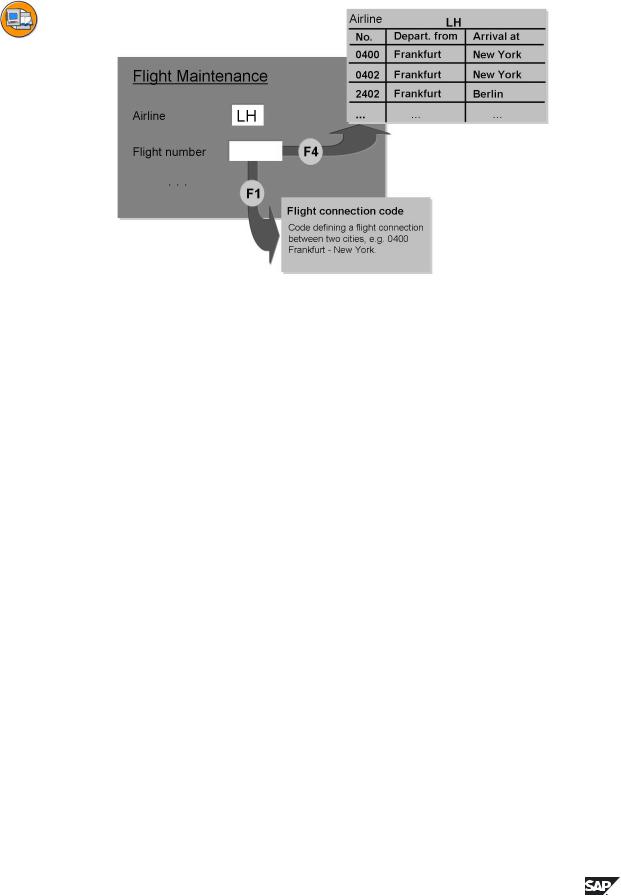
BC430 |
Lesson: Overview of the Functions of the ABAP Dictionary |
Figure 4: Services of the ABAP Dictionary
The ABAP Dictionary supports program development with a number of services:
•Input helps (F4 helps) for screen fields can be defined with search helps.
•Screen fields can easily be assigned a field help (F1 help) by creating documentation for the data element.
•An input check that ensures that the values entered are consistent can easily be defined for screen fields using foreign keys.
•The ABAP Dictionary provides support when you set and release locks. To do so, you must create lock objects in the ABAP Dictionary. Function modules for setting and releaing locks are automatically generated from these lock objects; these can then be linked into the application program.
•The performance when accessing this data can be improved for database objects (tables, views) with buffering settings.
•By logging, you can switch on the automatic recording of changes to the table entries.
2006/Q2 |
© 2007 SAP AG. All rights reserved. |
5 |
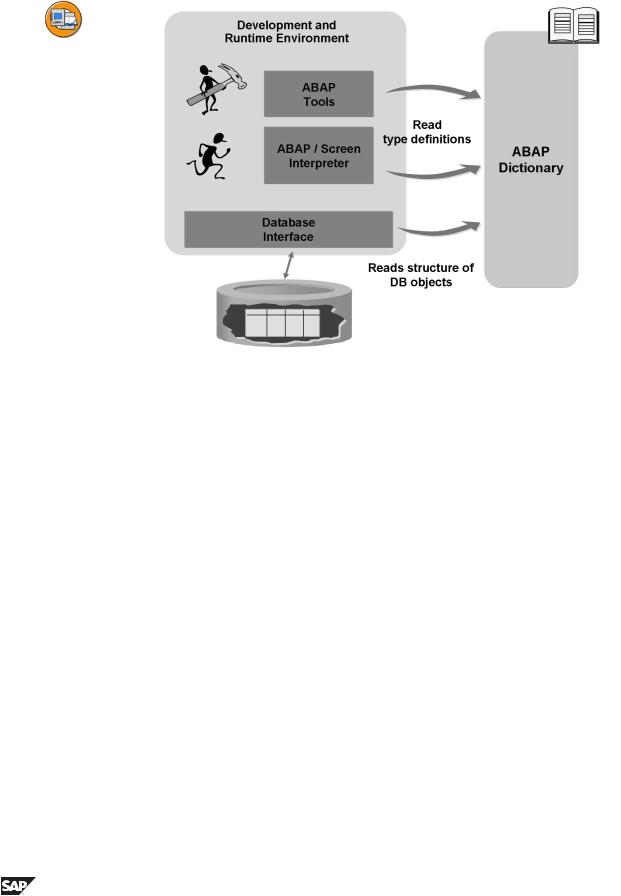
Unit 1: Introduction to the Dictionary |
BC430 |
Figure 5: Linking to the development and runtime environment
The ABAP Dictionary is actively integrated in the development and runtime environments. Each change takes immediate effect in the relevant ABAP programs and screens.
Examples:
•When a program or screen is generated, the ABAP interpreter and the screen interpreter access the type definitions stored in the ABAP Dictionary.
•The ABAP tools and the Screen Painter use the information stored in the ABAP Dictionary to support you during program development. An example of this is the Get from Dictionary function in the Screen Painter, with which you can place fields of a table or structure defined in the ABAP Dictionary in a screen.
•The database interface uses the information about tables or database views stored in the ABAP Dictionary to access the data of these objects.
6 |
© 2007 SAP AG. All rights reserved. |
2006/Q2 |

BC430 |
Lesson: Overview of the Functions of the ABAP Dictionary |
Lesson Summary
You should now be able to:
•Name the function of the ABAP Dictionary in the R/3 system
•Describe the possible ways of defining data objects and data types
•Describe the services provided by the ABAP Dictionary
•Explain how the ABAP Dictionary is linked to the development and runtime environments
2006/Q2 |
© 2007 SAP AG. All rights reserved. |
7 |

Unit Summary |
BC430 |
Unit Summary
You should now be able to:
•Name the function of the ABAP Dictionary in the R/3 system
•Describe the possible ways of defining data objects and data types
•Describe the services provided by the ABAP Dictionary
•Explain how the ABAP Dictionary is linked to the development and runtime environments
8 |
© 2007 SAP AG. All rights reserved. |
2006/Q2 |
